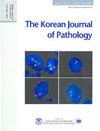Peritoneal Carcinosarcoma and Ovarian Papillary Serous Carcinoma Are the Same Origin: Analysis of TP53 Mutation and Microsatellite Suggests a Monoclonal Origin.
Korean Journal of Pathology
Pub Date : 2014-12-01
Epub Date: 2014-12-31
DOI:10.4132/KoreanJPathol.2014.48.6.449
引用次数: 3
Abstract
Carcinosarcoma is an aggressive malignant neoplasm of the female genital tract that is biphasic and composed of carcinomatous and sarcomatous components. It was previously considered as a subtype of uterine sarcoma but is currently regarded as a type of metaplastic carcinoma. 1 Here, we report a case in which a carcinosarcoma forming a discrete mass in the peritoneal cavity was diagnosed concurrently with smaller bilateral ovarian masses showing unequivocal histologic features of high-grade serous carcinoma. Although there seems to be a close relationship between the two tumors in this case, firm evidence for the histopathologic determination of the primary site is lacking because primary carcinosarcomas have been described in many extragenital organs, including the peritoneum, in the literature. We demonstrated two tumors with different histologic findings at distant tumor locations but with a common origin in their pathogenetic mechanism, as suggested by their similar immunohistochemical overexpression of p53 protein and identical pattern TP53 mutation and microsatellites (the reference panel, the Bethesda markers) by molecular analysis.



腹膜癌肉瘤和卵巢乳头状浆液性癌同源:TP53突变和微卫星分析提示单克隆起源
本文章由计算机程序翻译,如有差异,请以英文原文为准。
求助全文
约1分钟内获得全文
求助全文

 求助内容:
求助内容: 应助结果提醒方式:
应助结果提醒方式:


